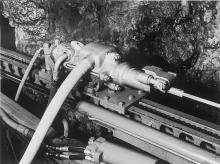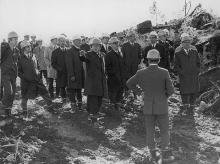
Development of mechanical drills represented a significant step forward for extracting aggregates. ABE takes a look at the development of the Tampella drill
The crushing of rock has always been one of the most difficult tasks for man - the innovation of mechanical hand-held drills was a significant improvement in terms of productivity. Chisel and hammer required two men, but air powered hand-held drills were operated by one man only. Naturally the productivity increased tremendously through the fact that the speed of making holes suddenly changed astronomically in comparison to old methods.
While hand-held drills really were a major improvement, they still required a lot of power, manpower that is. The penetration could only take place using the driller's personal force, requiring a lot of muscle.
Pneumatic hand-held drills were designed in two different categories, those of long-stroke frequency and those of short-stroke frequency. The short-stroke ones had one major disadvantage, namely the level of vibration. They vibrated a lot and with time, this caused a physical problem called White Finger Syndrome. The vibration affected the blood veins and decreased the blood circulation. Drills with long-stroke frequency had similar effects but not on the same scale.
One of the first manufacturers of drilling equipment was Tampella, a Finnish company and one of the largest companies in the country. Tampella became involved in the drilling business during World War II. At that time all drills had been imported, mainly from Sweden and the US and the war caused a discontinuation in the supply of spare parts.
Mines and quarries were in trouble. They turned to Tampella and asked the company to start the making the high-demand spares. Since Tampella had a big engineering facility and was involved in the manufacture of weapons, the company decided to start the spare parts manufacturing in 1943.
Later Tampella decided to go deeper into the drilling machine business and started to design rock drills of its own. The proper business then started in 1952, when the first drill was sold. In 1954, Tampella established a separate Rock Drill Division; until then the drills were designed and manufactured by a section of the company's Weapons Division and the sales was taken care of by a couple of engineers from the Water Turbine Division.
The design was based on the short-stroke frequency concept and was therefore not so end-user-friendly. Nevertheless, Tampella soon became the most important supplier of rock drills domestically, since for a long period after the war imports were heavily restricted due to lack of foreign currencies and nationally made products and machines were preferred.
Tampella was aware of the limitations of its drills and the need to reduce the impact of vibration. In 1956 they came up with a new solution that was called the Tampella method.
This method was based on two significant improvements. On top of the drill there was a cylinder where the compressed air was directed through a hose and further to the drill via a piston and a valve that controlled the flow of air. On the ground level there was a steel bar type of anchor that was attached to the rock. The cylinder and the anchor were connected with a chain and the air forced the drill to move downwards. The system also assisted in keeping the drill in steady position for the accuracy of drilled holes. Consequently, all the drill operator had to do was to keep the drill in place - no pushing by manual power was necessary.
With the Tampella method it was also possible to use larger sized and more efficient drills. Suddenly the penetration increased up to 800-900mm from the 500mm maximum with the old hand-held drills. The bigger drills also almost doubled the hole size up to 375mm which resulted in the number of holes to be drilled was smaller which also added up to the overall productivity and efficiency. The productivity of quarries entered a totally new era - never heard of before in Finland.
The new way of drilling spread around Finland rapidly. Unfortunately the company was not yet geared around marketing and export business in the 1950s, so the method never gained much access elsewhere. But it was so a good method that ten years later the Tampella method was given the 'Blue Ribbon' award by the magazine World Mining based on the method's introduction at a trade show in Czechoslovakia.
And what was the fate of Tampella's Rock Drill Division? It got a new name in 1969 - Tamrock - which is now synonymous with rock drilling worldwide.









